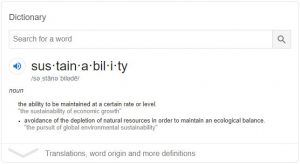
SUSTAINABILITY in Building Materials
There is so much talk nowadays in the building material industry and even more specifically, within the architectural community, with regards to choosing “sustainable” building materials and “sustainability” of buildings. But how do architects go about doing this and more importantly, what is it they should be looking for when choosing a “sustainable” building product? Is there a checklist? Is there a sustainability standard? To explore this further, let’s first get crystal clear on the definition of the word, “sustainability”:

Pulled directly from the great “Google” itself, the word “sustainability” simply means, the ability to be maintained at a certain rate or level. A sustainable building material therefore, one could derive from the definition, must have the characteristics of quality and reputability. But that is a very simple statement for a much more complex process when trying to determine exactly what is quality and reputability. Architects need to understand what the criterion is for “quality” and “reputability” and try and balance that with realistic client budgets and expectations. This can be a tricky balancing act to play when juggling constrained client budgets and high expectations, which is more often than not, the case for many architect firms.
Speaking from a manufacturer’s view point, no manufacturer will ever come right out and say that they do not have a quality product with no reputability and that isn’t sustainable. When asked the tough questions, the answer will always be yes, or some very complex and indirect form of no, that most architects would have a challenge deciphering. So how do you really get to the bottom of the real answers without being led astray? Here is a basic checklist of things to look for when trying to choose “sustainable” building materials for your next project:
1. How long has the company been in business? : This sometimes can be one of the greatest proofs of sustainability, quality and reputability; the test of time. Find out how long the company has been manufacturing for and if it is 10-20 years +, go out and visit projects that still have their materials installed to inspect the quality.
2. How many valid warranty claims have been placed on this particular product?: This is again one of those tough questions that the manufacturer may try to avoid when asked, but try and go further than the manufacturer. The inability of a building material to perform can end up negatively affecting various elements down the supply chain, including distributors and contractors. So don’t limit this question to the manufacturer, reach out to the products distributors and product applicators to find out if they’ve had many warranty claims and what the experience has been like. This can sometimes produce some of the most brutally honest feedback you can hope to hear.
3. What kind of testing and certifications do the products have?: An in depth look at the products adequate testing and certifications can answer a lot of questions with regards to quality and even sustainability. Again, from a manufacturer’s viewpoint, a tremendous amount of monetary resources is often dedicated to this area, so take the time to review and truly understand what the testing means and indicates with regards to the products performance, especially in specific climates. Some States have product approval codes that the product must achieve which indicates that there has been significant testing and quality control measures taken to ensure the product can withstand the States specific climatic diversity. Countries like Canada actually have a national certification program called CCMC (Canadian Construction Materials Centre), that holds building materials to a national standard and any product must meet a gauntlet of pre-determined test standards in order to be given a registered CCMC number.
4. Does the manufacturer have a North America recognized quality control program?: This goes one step further to examining the manufacturer’s product testing which is ensuring that the manufacturer has a North American recognized quality control program. This is a costly and timely initiative for any manufacturer to undertake, especially younger and smaller manufacturers like us. It is a question many architects never ask manufacturers but one that can really tell you a lot about the quality of the building material you are considering.
Ultimately, it is the manufacturer’s responsibility to ensure you have all of the adequate information at your disposal and that they make themselves available and accessible to answer any questions you may have. The due-diligence of choosing sustainable building materials for your client’s project can be timely and challenging at times, but don’t be afraid to hold the manufacturer accountable.


